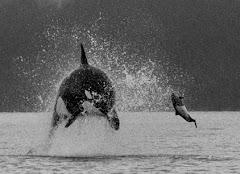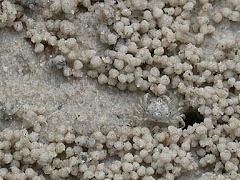 Yesterday and today we finished up crustaceans (crabs, shrimps, lobsters) and echinoderms (sea stars, sea urchins, sea cucumbers). Students took a test yesterday and a practical today and did fabulous on both of them. My fridge in the classroom is covered in A+ papers (encourage your student to bring these papers home to decorate the fridge at home).
Yesterday and today we finished up crustaceans (crabs, shrimps, lobsters) and echinoderms (sea stars, sea urchins, sea cucumbers). Students took a test yesterday and a practical today and did fabulous on both of them. My fridge in the classroom is covered in A+ papers (encourage your student to bring these papers home to decorate the fridge at home).Today as a Jump In we watched a rap video called What invert? covering a song by a rapper named TI. It's pretty amusing and now that the students know some invertebrates... they understand why some of it is pretty funny.
Next the students had 15 minutes to make a costume for the crustacean or invertebrate that they randomly chose. The results were awesome and hilarious. Enjoy the photos. :)
 Here is TJ the male fiddler crab with his giant claw (courtesy of Lauren, Mariah S, and Oneisha)
Here is TJ the male fiddler crab with his giant claw (courtesy of Lauren, Mariah S, and Oneisha) Next is Stacey with the Barnacle headdress (with the help of Courtney and Michelle)
Next is Stacey with the Barnacle headdress (with the help of Courtney and Michelle) Beth's mantis shrimp looked amazing... and she even pow=pow=powed me. (with help from Ashleigh and Victoria)
Beth's mantis shrimp looked amazing... and she even pow=pow=powed me. (with help from Ashleigh and Victoria) Mariah M modeled her spiny lobster costume... check out those antenna whips! (Her assistant was Ethan.
Mariah M modeled her spiny lobster costume... check out those antenna whips! (Her assistant was Ethan. Carl, Ramon, and Greg worked on costumes depciting the difference in abdomen's of boy and girl crabs... can you tell the difference? Here's a hint... girl crabs have to hold their eggs on their abdomen...
Carl, Ramon, and Greg worked on costumes depciting the difference in abdomen's of boy and girl crabs... can you tell the difference? Here's a hint... girl crabs have to hold their eggs on their abdomen...The girls, Kelsea, Kelsi, Sharron, and Jazzy made a beautiful brittle star, but I missed a photo of it when they presented. It is now hanging on my wall.
I assigned one table extra things... and did not capture them on film. I cannot beleive I do not have a picture of the amazing male horseshoe crab that Rick and Brandon designed... according to Rick, it is the third most ridiculous thing he's ever worn. Meg did a great acting out of a decorator crab and Justin wore a sea star design.




